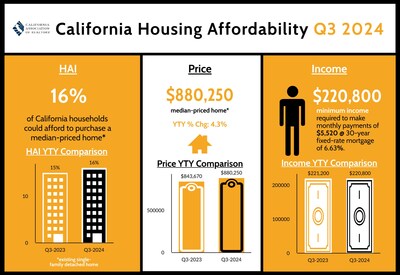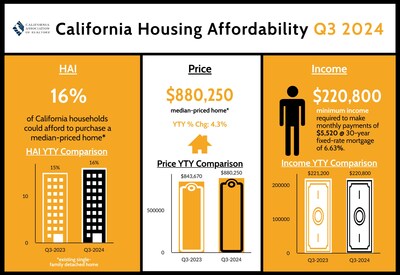- Sixteen percent of California households could afford to purchase the $880,250 median-priced home in the third quarter of 2024, up from 14 percent in second-quarter 2024 and up from 15 percent in third-quarter 2023.
- A minimum annual income of $220,800 was needed to make monthly payments of $5,520, including principal, interest and taxes on a 30-year fixed-rate mortgage at a 6.63 percent interest rate.
- Twenty-five percent of home buyers were able to purchase the $670,000 median-priced condo or townhome. A minimum annual income of $168,000 was required to make a monthly payment of $4,200.
LOS ANGELES, Nov. 7, 2024 /PRNewswire/ -- Slower home price growth and more favorable interest rates in third-quarter 2024 buoyed California's housing affordability from both the previous quarter and a year ago, the CALIFORNIA ASSOCIATION OF REALTORS® (C.A.R.) said today.
Infographic: https://www.car.org/Global/Infographics/HAI-2024-Q3
Sixteen percent of the state's homebuyers could afford to purchase a median-priced, existing single-family home in California in third-quarter 2024, up from 14 percent in the second quarter of 2024 and 15 percent in the third quarter of 2023, according to C.A.R.'s Traditional Housing Affordability Index (HAI).
The third-quarter 2024 figure is less than a third of the affordability index peak of 56 percent in the third quarter of 2012. Rates started the third quarter on a downward trend but have climbed since bottoming out in early September. With the dwindling chance of another sizable Fed rate cut in 2024 due to a stronger-than-expected economy, mortgage rates shot back up above 7 percent in recent weeks, reaching their highest levels since early July. Rates could still come down before the end of the year, but the odds of a meaningful decline in the next couple months have reduced sharply from where they were three months ago.
C.A.R.'s HAI measures the percentage of all households that can afford to purchase a median-priced, single-family home in California. C.A.R. also reports affordability indices for regions and select counties within the state. The index is considered the most fundamental measure of housing well-being for home buyers in the state.
A minimum annual income of $220,800 was needed to qualify for the purchase of an $880,250 statewide median-priced, existing single-family home in the third quarter of 2024. The monthly payment, including taxes and insurance (PITI) on a 30-year, fixed-rate loan, would be $5,520, assuming a 20 percent down payment and an effective composite interest rate of 6.63 percent. The effective composite interest rate was 7.10 percent in second-quarter 2024 and 7.14 percent in third-quarter 2023. The monthly PITI for a typical single-family home in California dipped from both the previous quarter and the same quarter of last year.
The statewide median price of existing single-family homes in California declined 2.9 percent quarter-to-quarter, due partly to seasonal factors but also a change in the mix of sales. On a year-over-year basis, California continued to record price increases for the fifth consecutive quarter, although at a more moderate pace of 4.3 percent in third-quarter 2024 – the slowest since the third quarter of 2023. With the market entering the off-season, home prices will soften further as inventory rises and competition cools. While slower price growth will ease the affordability crunch facing buyers, recent mortgage rate spikes will continue to be a challenge for many in the remainder of the year.
The share of California households that could afford a typical condo/townhome in third-quarter 2024 rose to 25 percent, up from 22 percent recorded in the previous quarter and up from the 23 percent recorded in the third quarter of 2023. An annual income of $168,000 was required to make the monthly payment of $4,200 on the $670,000 median-priced condo/townhome in the third quarter of 2024.
Compared with California, more than one-third of the nation's households could afford to purchase a $418,700 median-priced home, which required a minimum annual income of $105,200 to make monthly payments of $2,630. Nationwide affordability inched up from 34 percent a year ago. In the third quarter of 2024, the nationwide minimum required annual income was less than half that of California's for the sixth consecutive quarter.
Key points from the third-quarter 2024 Housing Affordability report include:
- On a quarter-to-quarter basis, housing affordability declined in only three counties and remained unchanged in another three. Forty-seven counties showed an improvement in affordability from second-quarter 2024 as a result of moderate price declines in those counties along with lower mortgage rates during the same time period. Compared to a year ago, 40 counties were more affordable, while six counties were less affordable, and seven remained unchanged.
- Lassen (52 percent) remained the most affordable county in California, followed by a two-way tie between Glenn and Tuolumne at 40 percent, and another two-way tie for the next rank between Amador and Tehama at 38 percent. Of all counties in California, Lassen continued to require the lowest minimum qualifying annual income ($66,000) to purchase a median-priced home in the third quarter of 2024.
- Mono (7 percent), Monterey (10 percent), and a two-way tie between Los Angeles and San Luis Obispo counties at 11 percent were the least affordable counties in the state, with each of them requiring a minimum annual income of at least $218,000 to purchase a median-priced home in the respective counties. San Mateo continued to require the highest minimum annual qualifying income ($514,400) to buy a median-priced home in third-quarter 2024 and was the only county in requiring a minimum qualifying annual income of more than $500,000. Santa Clara and San Francisco ranked second and third with a minimum required annual income of $476,800 and $396,400, respectively.
- While housing affordability improved in the majority of counties throughout the state due to higher household income and lower mortgage rates, home prices remained elevated throughout much of California despite softening from the previous quarter. As a result, housing affordability in one-fourth of the counties tracked by C.A.R. either remained unchanged or declined from the same quarter last year. Plumas (23 percent) experienced the biggest affordability drop, falling eight points from the third quarter of 2023. Lassen (52 percent) recorded the second biggest affordability drop, moving six points below the same quarter of last year. Merced (27 percent) and Sutter (28 percent) posted the third worst drop in affordability, with each decreasing three percentage points from a year ago. Housing affordability in California remained near its all-time low across the state and continued to be a challenge for both buyers and sellers.
See C.A.R.'s historical housing affordability data.
See first-time buyer housing affordability data.
Leading the way…® in California real estate for nearly 120 years, the CALIFORNIA ASSOCIATION OF REALTORS® (www.car.org) is one of the largest state trade organizations in the United States with 200,000 members dedicated to the advancement of professionalism in real estate. C.A.R. is headquartered in Los Angeles.
CALIFORNIA ASSOCIATION OF REALTORS®
| ||||||||
Qtr. 3 2024 | C.A.R. Traditional Housing Affordability Index | |||||||
STATE/REGION/COUNTY | Qtr. 3 | Qtr. 2 | Qtr. 3 | Median | Monthly | Minimum | ||
Calif. Single-family home | 16 | 14 | 15 | $880,250 | $5,520 | $220,800 | ||
Calif. Condo/Townhome | 25 | 22 | 23 | $670,000 | $4,200 | $168,000 | ||
Los Angeles Metro Area | 15 | 13 | 14 | $827,000 | $5,190 | $207,600 | ||
Inland Empire | 22 | 20 | 20 | $590,000 | $3,700 | $148,000 | ||
San Francisco Bay Area | 21 | 18 | 19 | $1,275,000 | $8,000 | $320,000 | ||
United States | 35 | 33 | 34 | $418,700 | $2,630 | $105,200 | ||
San Francisco Bay Area | ||||||||
Alameda | 18 | 16 | 16 | $1,275,000 | $8,000 | $320,000 | ||
Contra Costa | 25 | 21 | 22 | $875,000 | $5,490 | $219,600 | ||
Marin | 20 | 16 | 18 | $1,575,000 | $9,880 | $395,200 | ||
Napa | 15 | 14 | 15 | $975,000 | $6,120 | $244,800 | ||
San Francisco | 21 | 19 | 21 | $1,580,000 | $9,910 | $396,400 | ||
San Mateo | 17 | 16 | 17 | $2,050,000 | $12,860 | $514,400 | ||
Santa Clara | 19 | 16 | 17 | $1,900,000 | $11,920 | $476,800 | ||
Solano | 26 | 24 | 24 | $600,000 | $3,760 | $150,400 | ||
Sonoma | 18 | 16 | 15 | $835,000 | $5,240 | $209,600 | ||
Southern California | ||||||||
Imperial | 28 | 26 | 27 | $395,000 | $2,480 | $99,200 | ||
Los Angeles | 11 | 13 | 11 | $947,480 | $5,940 | $237,600 | ||
Orange | 12 | 11 | 11 | $1,398,500 | $8,770 | $350,800 | ||
Riverside | 21 | 18 | 19 | $635,000 | $3,980 | $159,200 | ||
San Bernardino | 27 | 25 | 25 | $510,000 | $3,200 | $128,000 | ||
San Diego | 12 | 11 | 11 | $1,010,000 | $6,340 | $253,600 | ||
Ventura | 13 | 12 | 13 | $950,000 | $5,960 | $238,400 | ||
Central Coast | ||||||||
Monterey | 10 | 8 | 9 | $950,000 | $5,960 | $238,400 | ||
San Luis Obispo | 11 | 11 | 10 | $940,500 | $5,900 | $236,000 | ||
Santa Barbara | 13 | 9 | 10 | $950,000 | $5,960 | $238,400 | ||
Santa Cruz | 14 | 13 | 13 | $1,319,000 | $8,280 | $331,200 | ||
Central Valley | ||||||||
Fresno | 30 | 28 | 27 | $430,000 | $2,700 | $108,000 | ||
Glenn | 40 | 35 | 30 | $327,000 | $2,050 | $82,000 | ||
Kern | 30 | 30 | 28 | $405,000 | $2,540 | $101,600 | ||
Kings | 33 | 29 | 27 | $375,000 | $2,350 | $94,000 | ||
Madera | 31 | 29 | 29 | $426,940 | $2,680 | $107,200 | ||
Merced | 27 | 25 | 30 | $413,000 | $2,590 | $103,600 | ||
Placer | 30 | 28 | 27 | $670,000 | $4,200 | $168,000 | ||
Sacramento | 26 | 24 | 23 | $560,000 | $3,510 | $140,400 | ||
San Benito | 21 | 18 | 16 | $800,000 | $5,020 | $200,800 | ||
San Joaquin | 25 | 24 | 23 | $572,950 | $3,590 | $143,600 | ||
Stanislaus | 29 | 25 | 24 | $480,000 | $3,010 | $120,400 | ||
Tulare | 31 | 30 | 30 | $380,000 | $2,380 | $95,200 | ||
Far North | ||||||||
Butte | 29 | 27 | 28 | $450,000 | $2,820 | $112,800 | ||
Lassen | 52 | 52 | 58 | $262,500 | $1,650 | $66,000 | ||
Plumas | 23 | 29 | 31 | $520,000 | $3,260 | $130,400 | ||
Shasta | 34 | 33 | 35 | $385,000 | $2,420 | $96,800 | ||
Siskiyou | 36 | 31 | 34 | $312,500 | $1,960 | $78,400 | ||
Tehama | 38 | 34 | 39 | $325,000 | $2,040 | $81,600 | ||
Trinity | 34 | 28 | 30 | $275,000 | $1,730 | $69,200 | ||
Other Calif. Counties | ||||||||
Amador | 38 | 32 | 26 | $416,000 | $2,610 | $104,400 | ||
Calaveras | 31 | 29 | 27 | $485,000 | $3,040 | $121,600 | ||
Del Norte | 28 | 34 | 28 | $420,000 | $2,630 | $105,200 | ||
El Dorado | 27 | 22 | 23 | $665,000 | $4,170 | $166,800 | ||
Humboldt | 23 | 22 | 23 | $439,900 | $2,760 | $110,400 | ||
Lake | 35 | 31 | 30 | $343,000 | $2,150 | $86,000 | ||
Mariposa | 27 | 25 | 16 | $409,000 | $2,570 | $102,800 | ||
Mendocino | 18 | 17 | 15 | $549,000 | $3,440 | $137,600 | ||
Mono | 7 | 5 | 5 | $869,000 | $5,450 | $218,000 | ||
Nevada | 26 | 24 | 23 | $577,000 | $3,620 | $144,800 | ||
Sutter | 28 | 27 | 31 | $430,000 | $2,700 | $108,000 | ||
Tuolumne | 40 | 31 | 31 | $385,000 | $2,420 | $96,800 | ||
Yolo | 24 | 22 | 23 | $615,000 | $3,860 | $154,400 | ||
Yuba | 27 | 25 | 26 | $440,000 | $2,760 | $110,400 | ||
r = revised
Traditional Housing Affordability Indices (HAI) were calculated based on the following effective composite interest rates: 6.63% (3Qtr. 2024), 7.10% (2Qtr. 2024) and 7.14% (3Qtr. 2023). | ||||||||
![]() View original content to download multimedia:https://www.prnewswire.com/news-releases/california-housing-affordability-improves-from-previous-quarter-and-year-as-price-growth-ebbs-and-rates-dip-car-reports-302298926.html
View original content to download multimedia:https://www.prnewswire.com/news-releases/california-housing-affordability-improves-from-previous-quarter-and-year-as-price-growth-ebbs-and-rates-dip-car-reports-302298926.html
SOURCE CALIFORNIA ASSOCIATION OF REALTORS® (C.A.R.)
© 2024 Benzinga.com. Benzinga does not provide investment advice. All rights reserved.










